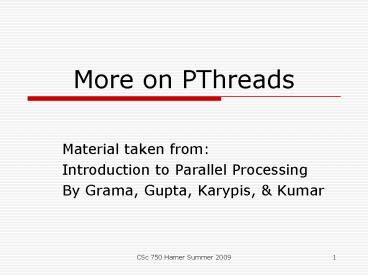More on PThreads PowerPoint PPT Presentation
1 / 21
Title: More on PThreads
1
More on PThreads
- Material taken from
- Introduction to Parallel Processing
- By Grama, Gupta, Karypis, Kumar
2
Programming Shared Address Space
- All memory is accessible to all processors
- Process based models assume that memory is
private and hidden from other processors (high
overhead to access) - Lightweight processes (threads) assume all memory
is global - Threads support faster memory manipulation
(preferred model for parallel programming)
3
What are Threads?
- Basic code segment w/o threadsfor(row0 rowltn
row) for(col0 colltn col) crowcol
dot_product(get_row(a,
row),
get_col(b,col))
4
What are Threads?
- Basic code segment with threadsfor(row0 rowltn
row) for(col0 colltn col) crowcol
create_thread(
dot_product(get_row(a,row),
get_col(b,col)))
5
What are Threads?
- Notice that the thread model will allow each row
column product to be computed in parallel if
multiple processors exist. - The underlying systems must schedule the tasks on
multiple processors
6
Logical Memory Model of a Thread
- In order to execute the previous code, each
thread needs access to matrices a, b, and c. - How we think of memory is below
7
Logical Memory Model of a Thread
- Actual memory model
- M represents local stack based memory
8
Why use Threads?
- Software Portability
- Can be developed on serial machines and run on
parallel machines w/o change - Latency Hiding
- A major overhead is memory, I/O, and
communication latency - When one thread is blocked, another can proceed
- While one thread waiting on communication another
can operate
9
Why use Threads?
- Scheduling and Load Balancing
- Threaded APIs allow the programmer to specify a
large number of concurrent tasks - Minimizes idling overhead
- Frees the programmer from explicit scheduling and
load balancing - Done by the OS
10
Why use Threads?
- Ease of Programming
- Easier to write than message passing programs
using tools like MPI and PVM - Be aware that we may lose some efficiencies that
we once had - POSIX threads have become a standard and are in
wide use
11
Thread Basics Creation and Termination
- Threads are created using the pthread_create
functionint pthread_create( pthread_t
thread_handle, const pthread_attr_t
attribute, void (thread_function)
(void), void arg)
12
Thread Basics Creation and Termination
- Pthread_create will create a single thread that
corresponds to the invocation of thread_function - The attribute argument is usually NULL, but can
specify things like scheduling type - A unique id associated with the thread is
returned to thread_handle
13
Thread Basics Creation and Termination
- The arg field is used to pass parameters to the
thread - We must be careful since thread creation can
preempt its creator on a single processor system - On successful creation pthread_create will return
0, otherwise an error code is returned
14
Threaded pi Computation
- We will next look at code to compute pi based on
random numbers - Use a unit square and count the number of points
that fall within the largest circle inscribed on
the square
15
Threaded pi Computation
- Since the area of a circle ( ) is equal to (
), and the area of a square is 1 x 1, the
fraction of points in the circle should approach - A simple threaded strategy for generating the
value of assigns a fixed number of points to
each thread
16
Threaded pi Computation
- Each thread will generate random points and keeps
track of the number of points that land in the
circle. - Upon termination of all threads, their counts are
combined to compute the final value. - We know how to create threads, we just need to
use another function to implement the final join
17
Threaded pi Computation
- The pthread_join functionint pthread_join
( pthread_t thread, void ptr) - A call to this function waits for the termination
of the thread whose id is given by the parameter
thread
18
Threaded pi Computation
- The actual computation proceeds as follows
- Read in desired number of threads
- Read in the desired number of sample points
- Divide points between the threads
- Use an array hits to hold the count of hits
(points outside the circle) by thread - Create number of threads and call compute_pi
19
Threaded pi calculation
- http//www.cs.sdstate.edu/hamerg/csc750/threadedp
i.c
20
Thread Basics Creation and Termination
- rand_r
- Reentrant
- Safe to reenter if disrupted
- 0..RAND_MAX
- rand_no_x (y) are 0..1
- Circle radius is 0.5 (0..0.5)
- False Sharing
- Second version updates shared resource not local
resource - 100,000,000 points
- 4 threads 10x longer
- 1 thread about the same
21
Monte Carlo Pi Calculation
- Estimate Pi by throwing darts at a unit square
- Calculate percentage that fall in the unit circle
- Area of square r2 1
- Area of circle quadrant ¼ p r2 p/4
- Randomly throw darts at x,y positions
- If x2 y2 lt 1, then point is inside circle
- Compute ratio
- points inside / points total
- p 4ratio

